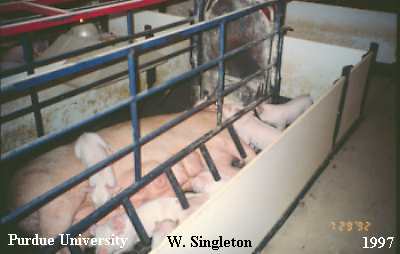
Purdue Pork Page Archive
How to ...
manage difficult farrowings
W Singleton, SF Amass, LK Clark, LJ Runnels

Fortunately, difficult farrowings are not very common in present swine production systems. The sow will need help in less than 1% of all farrowings. Sows about to farrow should be observed approximately every 30 to 60 minutes. Familiarizing yourself with the normal birthing process is the first step in knowing when your intervention is needed.
Provide a clean and dry farrowing environment. Move sows to farrowing quarters from 1 to 5 days prior to the expected farrowing date.
Behavior of the sow pre-farrowing
Signs of a difficult farrowing
How to examine the birth canal
Types of farrowing problems and methods of assistance
Behavior of the sow prefarrowing
|
Approximate time before delivery |
Sow characteristics/ behavior |
|---|---|
|
0-10 days |
Mammary glands enlarge and become firm |
|
0-10 days |
Swelling of the vulval lips |
|
2 days |
Mammary glands become turgid and tense and secrete a clear fluid |
|
12-24 hours |
Mammary glands begin to secrete milk |
|
12-24 hours |
|
|
6 hours |
Abundant milk secretion |
|
30 minutes-4 hours |
Increased respiration |
|
15-60 minutes |
Sow quiets and lies down on her side |
|
30-90 minutes |
Straining, passage of blood tinged, oily fluid and meconium ( fetal feces) |
Rectal temperature is not a reliable predictor of farrowing
Signs of a difficult farrowing
How to examine the birth canal
***When the time between the birth of pigs exceeds one hour, intervention by the manager is necessary.
***Intervention must be gentle. The tissues of the birth canal are easily bruised and torn. Damage can lead to swelling, hemorrhage, and death of the sow and litter. Excessive damage can also negate the option of the use of a cesarean section as a treatment.
Types of farrowing problems and methods of assistance
***Never use oxytocin before determining the cause of the problem
|
Type of problem |
Method of assistance |
|---|---|
|
Uterine inertia (the uterus is unable to contract) |
Manual intervention: be certain that the sow is dilated and nothing is blocking the birth canal Deliver any pigs within reach- grasp the pig by the snout (image1, image 2) or use a snare (image 1, image 2) Administer oxytocin Get the sow up Cool the sow with a mister or fan Call veterinarian if farrowing does not occur |
|
Improper presentation of pig |
|
|
Manual intervention: Hook your index finger under the hock of each hind leg. Extend the legs caudally or use a snare. |
|
|
Manual intervention: Grasp head, lower jaw, or feet to deliver one pig at a time |
|
|
Manual intervention: Grasp head, lower jaw, or feet |
|
Canal obstruction |
|
|
Manual dilation or severing with scissors |
|
Call veterinarian |
|
Call veterinarian |
|
Manually remove feces Give enema of warm, soapy water |
|
Get sow to stand up and force exercise Give oxytocin Rarely the veterinarian will have to catheterize bladder |
|
|
Deviation of the uterus |
|
|
Call veterinarian |
|
|
Manual intervention |
|
|
Pig is too large |
Call veterinarian |
|
Give tranquilizer as prescribed by veterinarian Give oxytocin Remove pigs until sow is quiet and finished farrowing |
|
|
Retained placenta/ blood or pus discharge |
Rare- usually indicates that one or more pigs is present in the reproductive tract-Call veterinarian |
|
Vaginal, uterine or bladder prolapse |
Call veterinarian |
|
Hemorrhage |
Call veterinarian |
Purdue Pork Page Archive